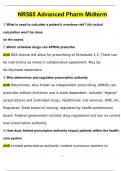NR565 Advanced Pharm Midterm
1.What is used to calculate a patient's overdose risk? (An actual calculation won't be done
on the exam):
2.Which schedule drugs can APRNs prescribe
ANS DEA license will allow for prescribing of Schedules 2-5. There can
be restrictions as noted in collaborative agreement. May be facility/state dependent.
3.Who determines and regulates prescriptive authority
ANS Determines: Also known as independent prescribing. APRNS can prescribe without limitation and is state dependent. Includes "legend" (prescription) and controlled drugs, health/med- ical services, DME, etc.
Regulates: State board of nursing, regulated by health professional board. Federal government controls drug regulations but has no control over prescriptive authority.
4.How does limited prescriptive authority impact patients within the health-
care system
ANS Limited prescriptive authority creates numerous barriers to quality, affordable, and accessible patient care. For example, restrictions on the distance of the APRN or PA from the physician providing supervision or collaboration may prevent outreach to area of greatest need. An increase in patient waits.
5.What are the key responsibilities of prescribing
ANS The ability to prescribe medications is both a privilege and a burden. Have a documented provider-patient relationship, do not prescribe medications to family or friends or yourself, Document a thorough history and physical examination, include any discussions you have with the patient about risk factors, side effects, or therapy options, have documented plan regarding drug monitoring or titration, if you consult additional providers not that you did so. Use the references provided in the following boxes to assist in safely and rationally choosing one medication over another.
Be sensible, accept responsibility, do not fear it, know constraints and limitations, always learn and update, keep Rx pads in safe place, confirm
allergies, verify medication list with patient, do not let insurance dictate quantity of Rx, Charting is key (particularly with off label use), Provide use and rationale. .What should be used to make prescribing decisions
ANS The best way to keep your patients (and yourself) safe is to be prudent and deliberate in your decision-making process. Cost, availability, current practice guidelines, medication interactions including interactions with food, side effects, need for monitoring, how
drug is metabolized (hepatic or renal), special populations (pregnancy, nursing, older adults)
7.Be familiar with pharmacokinetic and pharmacodynamic changes of older adults and how that would translate to baseline information needed to
pre- scribe: ANS Pharmacokinetic is the study of drug absorption, distribution, metabolism, and excretion in the body. The ability of older adults to metabolize drugs is commonly decreased. Drug dosages may need to be reduced to prevent drug toxicity.
8.Beer's criteria: ANS Guidelines for prescribing medications to patients 65 & older. Drugs on the list should be avoided in patients over 65 expect when the benefits significantly outweigh the risks. The Beers Criteria includes five lists that describe certain medications and situations and include: potentially inappropriate medication (PIM) us in older adults, PIM use in older adults due to medication-disease or medication-syndrome interactions that may exacerbate the disease or syndrome, medications to be used cautiously in older adults, clinically significant drug interac- tions that should be avoided in older adults, medications to be avoided or dosage decreased in the presence of impaired kidney function in older adults.
9.Why is Beer's criteria important
ANS It provides a list of medications that are potentially harmful in elderly. List that identifies drugs with a high likelihood of caus- ing adverse effects in older adults. Beers Criteria are recommendations;




